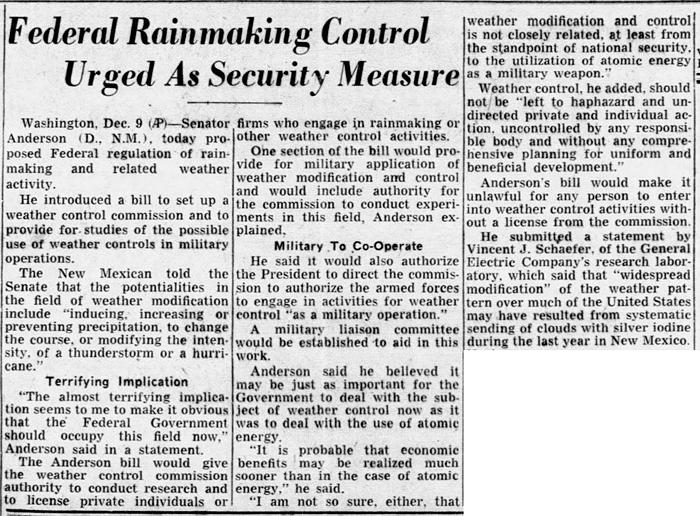Weather Control Commission
In 1950, Senator Clinton P. Anderson of New Mexico introduced a bill in the Senate to create a federal "Weather Control Commission" modeled after the Atomic Energy Commission. Its purpose would be to regulate and license rainmaking activities in order to ensure the "equitable distribution of precipitation among the States." It would also study military applications of weather control.
Anderson didn't get his Weather Control Commission, though in 1953 the federal government did create an Advisory Committee on Weather Control. And of course there are all those conspiracy theories alleging that the government is using the HAARP station up in Alaska to control the weather.
More info: Congressional Hearings, March 1951

Anderson didn't get his Weather Control Commission, though in 1953 the federal government did create an Advisory Committee on Weather Control. And of course there are all those conspiracy theories alleging that the government is using the HAARP station up in Alaska to control the weather.
More info: Congressional Hearings, March 1951

Baltimore Sun - Dec 10, 1950
Comments
I think the government knew they had a good thing going "sans any liability". And I would like to note the misspelling of seeding so "Cloud Seeding" searches would NOT produce this article. Am I paranoid? Are the CCP really wringing the world dry at the Himalayas as they mismanage rerouting 3/4 of the rivers and Damning the headwaters from other countries? Coupcoup or cray cray?
Posted by John Church on 10/03/22 at 08:29 AM
Sounds like something right out of a science fiction story. Imagine the amount of energy needed!
Posted by KDP on 10/03/22 at 04:35 PM
The proposition, however, sounds like a campaign promess made by Vermin Supreme or the Rhinoceros Party. "If I am elected, I will ensure the equitable distribution of precipitations among the States. No more drought in California! No more gloomy weather in Seattle! Sunshine for everyone!"
Posted by Yudith on 10/04/22 at 05:53 AM
And even today, there are paranoiacs running around believing that the CIA is controlling the weather to create more hurricanes to punish Florida for letting the FBI into Mar-A-Lago...
Posted by Richard Bos on 10/08/22 at 07:44 AM
Commenting is not available in this channel entry.



Category: Government | 1950s | Weather